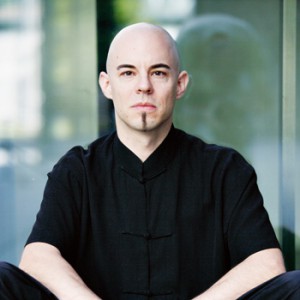English translation below
Afgewogen acoustische kamerminimal. Geen noot teveel
CD Continuum (ECM) van Nik Bärtsch’s Mobile
De Zwitserse pianist Nik Bärtsch werkt al jaren met twee verschillende ensembles: Mobile, zijn acoustische groep en Ronin, zijn meer electrische zen-funk band.
Met Mobile bracht hij nu een nieuwe CD uit Continuum; muziek met weinig frases en motieven, die herhaald worden en voortdurend anders gecombineerd en op nieuwe manieren over elkaar gelegd. Met elementen uit jazz, hedendaage muziek, minimal, en ook rituele muziek.
26-3 TivoliVredenburg Utrecht (tijdens het Transition Festival), 13-4 Paradox Tilburg, 14-4 LantarenVenster Rotterdam
Mobile bestaat behalve Bärtsch uit Kaspar Rast (drums), Sha (basclarinet) and Nicolas Stocker (slagwerk). Opgericht in 1997 is de groep een soort ‘community’, die meegaat in Bärtsch’s rituele benadering van muziek maken.
Het gaat in deze muziek dan ook niet om individuele virtuositeit of soloos spelen, maar om een gezamelijke energie.
Mobile heeft wel marathon-concerten gegeven van 36 uur, waarbij ook licht, ruimtelijke vormgeving, video en zwaardvechten een rol speelden. Ingewikkelde artistieke rituelen dus.
In reactie hierop richtte hij in 2001 zijn zen-funk kwartet RONIN op, waar losser en flexibeler en ook funkier kon worden gespeeld. Maar in beide ensembles praktiseert Bärtsch zijn credo uit de Aziatische Martial Arts, dat als je maar lang genoeg oefent, datgene wat je oefent zelf ook verandert. Door de eindeloze herhaling van motieven krijgt de muziek een eigen dynamiek en ontwikkeling.
Zijn muziek roept daarom ook altijd associaties op met minimal music. Hij bedient zich daarbij meestal van ritme en beats als drijvende krachten.
Op de nieuwe Cd zorgen in drie stukken de toegevoegde strijkers voor een kamermuziekkarakter.
Ondanks het feit dat de muziek streng gestructureerd is, is er toch nog wel wat ruimte voor improvisatie. Eén bepaalde stem binnen een compositie krijgt bijvoorbeeld de vrijheid om steeds anders interactief te communiceren met de opgeschreven patronen van de anderen. Compositorische precisie versus improvisatorische afwijkingen
Inspiratie voor dit album kwam oa van een stuk van componist György Ligeti: Continuum for Harpsichord (1968).
Ligeti’s ritmische finesse, zijn belangstelling voor Nieuwe Muziek en zijn zoeken naar nieuwe oplossingen voor het combineren van oude en nieuwe muziek spraken hem daarin aan.
Nik Bärtsch (1971) is door een krant in Zurich eerder wel eens ‘the scientist of groove’ genoemd. Hij studeerde aan de Musikhochschule in Zürich en later filosofie en linguistiek aan de universiteit aldaar. Later verbleef hij nog een paar jaar in Japan. In 1980 al startte hij zijn eerste bandje met slagwerker Kaspar Rast (1972). Vanaf 2001 werd hij leider van zijn zen-funk kwintet Ronin. Ook speelt hij veel solo, op een met percussie geprepareerde piano.
Over Ronin staat HIER ook nog een blog op deze site.
Complexe ritmes over elkaar heen gelegd met lange repeterende patronen en subtiele en dan weer plotselinge veranderingen.
ENGLISH
Balanced acoustic chamber minimal. Not one superfluous note
CD Continuum (ECM) Nik Bärtsch’s Mobile
Swiss pianist Nik Bärtsch has been working with two different ensembles: Mobile, his acoustic group and Ronin, his more electric zen-funk band.
Mobile he just released a new CD Continuum, music in which short phrases and motifs are repeated, constantly combined and layered in different new ways.
With elements from jazz, contemporary music, minimal, and ritual music. Mobile consists of Nik Bärtsch – piano, Kaspar Rast (drums), Sha (bass clarinet) and Nicolas Stocker (percussion). Founded in 1997, the group created a kind of ‘community’, going along with Bärtsch’s ritual approach to music.This music is not about individual virtuosity or playing soloos, it’s about a common energy.
Mobile performs marathon concerts of 36 hours sometimes, including light, spatial design, video and swordsmanship play a role. Complex artistic rituals they are.
In reaction, Nik Bärtsch founded in 2001, zen-funk quartet RONIN, where the playing was looser and more flexible and funkier too. But in both ensembles Bärtsch practices his creed of Asian martial arts, that if you practice long enough, what you practice is changing itself. The endless repetition of musical motifs creates its own dynamics and development.
His music therefore always evokes associations with minimal music. Thereby he usually makes use of rhythm and beats as driving forces.
On the new CD concerns into three pieces added strings to a chamber music character.
Despite the fact that the music is strictly structured, there is still some room for improvisation. One particular voice within a composition, for example, gets the freedom to communicate interactively with the written patterns of the others. Compositional precision versus improvisational variations.
Inspiration for this album came ao from a piece by composer György Ligeti: Continuum for Harpsichord (1968). Ligeti’s rhythmic finesse, his interest for New Music and search for new solutions to combine old and new music apealed to him.
 Nik Bärtsch (1971) was called ‘the scientist or groove’ s in a Zurich newspaper earlier. He studied at the Hochschule in Zurich and later philosophy and linguistics at the university there. Later he resided in Japan for a few years. In 1980 he started his first band with drummer Kaspar Rast (1972). In 2001 he became leader of his zen-funk quintet Ronin. He also performs solo a lot, on a prepared piano with percussion.
Nik Bärtsch (1971) was called ‘the scientist or groove’ s in a Zurich newspaper earlier. He studied at the Hochschule in Zurich and later philosophy and linguistics at the university there. Later he resided in Japan for a few years. In 1980 he started his first band with drummer Kaspar Rast (1972). In 2001 he became leader of his zen-funk quintet Ronin. He also performs solo a lot, on a prepared piano with percussion.
About Ronin there’s a blog on this site (HERE). Complex rhythms layering on each other with long repeating patterns and subtle and then sometimes sudden changes.